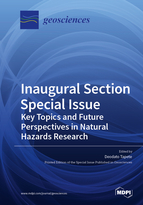Inaugural Section Special Issue: Key Topics and Future Perspectives in Natural Hazards Research
A special issue of Geosciences (ISSN 2076-3263). This special issue belongs to the section "Natural Hazards".
Deadline for manuscript submissions: closed (30 June 2019) | Viewed by 116731
Special Issue Editor
Interests: earth observation; radar and optical remote sensing; InSAR; time series analysis; Earth Sciences; environmental geology; natural hazards; urban environments; geoheritage; geoconservation; cultural heritage
Special Issues, Collections and Topics in MDPI journals
Special Issue Information
This Special Issue inaugurates the new section of Geosciences devoted to Natural Hazards.
The research in this scientific domain is very dynamic and diverse, encompassing, for example:
- new findings in understanding triggering and propagation mechanisms
- the revision of previous hypotheses or hazard scenarios
- the development of new conceptualisations and methodologies
- the testing of new data, sensors, and techniques for investigation, monitoring, change detection, and multi-temporal or back-analysis
- the development of new or refined models for forecasting
- the integration of hazard assessment in risk analysis
- the design of new materials and solutions for risk mitigation
- the exploration of new ways to communicate hazards and increase awareness
Significant advances are also achieved through multidisciplinary and international collaborations, as well as international partnerships, thus producing a multitude of different positive results including, but not limited to, shared standards, improved research capabilities, and new paradigms, not to mention the impact on society whenever research translates into practice, regulation, or policies.
I launch this Special Issue to capture the state-of-the-art of Natural Hazards research through a collection of review papers focused on current key topics, which outline where we are as a research community and future perspectives.
This Special Issue will include invited papers written by scholars of international reputation in this field of research, but also welcomes unsolicited, high-quality manuscripts on the above topics.
Therefore, prospective authors are encouraged to send in an abstract including the description of the key topic they want to address, the justification of its relevance in the current international research on Natural Hazards, and the specific audience and readership they want to reach.
Dr. Deodato Tapete
Guest Editor
Manuscript Submission Information
Manuscripts should be submitted online at www.mdpi.com by registering and logging in to this website. Once you are registered, click here to go to the submission form. Manuscripts can be submitted until the deadline. All submissions that pass pre-check are peer-reviewed. Accepted papers will be published continuously in the journal (as soon as accepted) and will be listed together on the special issue website. Research articles, review articles as well as short communications are invited. For planned papers, a title and short abstract (about 100 words) can be sent to the Editorial Office for announcement on this website.
Submitted manuscripts should not have been published previously, nor be under consideration for publication elsewhere (except conference proceedings papers). All manuscripts are thoroughly refereed through a single-blind peer-review process. A guide for authors and other relevant information for submission of manuscripts is available on the Instructions for Authors page. Geosciences is an international peer-reviewed open access monthly journal published by MDPI.
Please visit the Instructions for Authors page before submitting a manuscript. The Article Processing Charge (APC) for publication in this open access journal is 1800 CHF (Swiss Francs). Submitted papers should be well formatted and use good English. Authors may use MDPI's English editing service prior to publication or during author revisions.
Benefits of Publishing in a Special Issue
- Ease of navigation: Grouping papers by topic helps scholars navigate broad scope journals more efficiently.
- Greater discoverability: Special Issues support the reach and impact of scientific research. Articles in Special Issues are more discoverable and cited more frequently.
- Expansion of research network: Special Issues facilitate connections among authors, fostering scientific collaborations.
- External promotion: Articles in Special Issues are often promoted through the journal's social media, increasing their visibility.
- Reprint: MDPI Books provides the opportunity to republish successful Special Issues in book format, both online and in print.
Further information on MDPI's Special Issue policies can be found here.






